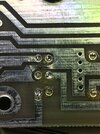Texas Star DX667V, all Toshiba's. It takes near a 2w deadkey to key it up and by then the amp deadkey out is 180w, so using the variable to tame it back to 120'ish and the swing is the expected 500w PEP. I was told it could be the relay is dirty, so I cleaned it, still the same thing. My question is could it be the relay, or parts that drive the relay?
I tried this, keyed the radio with 1w, didn't trigger it, TAPPED the relay and voila, it kicks in and with the expected 120'ish out without turning down the variable. I was able to repeat this several times. To me its more than likely a mechanical issue with the relay than an electrical one.
Has anyone else had this issue? I ordered a replacement relay and will be changing it this week. Thanks!
I tried this, keyed the radio with 1w, didn't trigger it, TAPPED the relay and voila, it kicks in and with the expected 120'ish out without turning down the variable. I was able to repeat this several times. To me its more than likely a mechanical issue with the relay than an electrical one.
Has anyone else had this issue? I ordered a replacement relay and will be changing it this week. Thanks!
Last edited:

